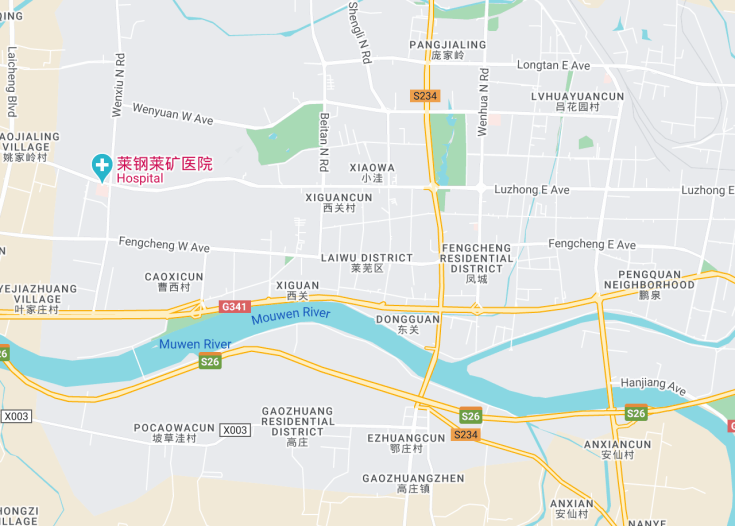Laiwu, a district in Jinan city, Shandong Province, China, is celebrated for its rich cultural heritage and stunning natural landscapes. Known for its steel production and agricultural prowess, Laiwu boasts a harmonious blend of modern industry and traditional farming villages. The area is surrounded by lush green mountains and is home to pivotal historical sites, offering a unique glimpse into China’s ingress of industrialization intertwined with its ancient customs. Exploring Laiwu offers a profound insight into the evolution of Chinese society and its enduring traditions.
Ensure to visit the Laiwu Campaign Memorial to delve into the local history, and don’t miss enjoying the freshly picked Red Fuji apples, a regional specialty.
Plan your visit during the spring to witness the spectacular peach blossoms across Laiwu, which provide a beautiful backdrop for hiking in its scenic mountains.
Top things to do & see in Laiwu
Select the following sights and activities to discover best tickets and tours available in Laiwu.
Laiwu: The Heart of Eastern China’s Development
| Country | China |
| Time in Laiwu | GMT+8 |
| Language spoken | Mandarin |
| Population | 1.24 million (according to World Population Review 2023) |
| Currency | Chinese Yuan (¥, CNY) |
| Airports |
|
Laiwu, now integrated into Jinan, the capital city of Shandong Province, serves as a vital hub for steel production and agricultural prowess in eastern China. The district is steeped in ancient Chinese history yet vibrates with modern industrial life. Famous for its oriental cherry blossoms, Laiwu attracts numerous visitors with its beautiful landscapes and cultural festivals driven by its rich historical heritage and thriving community.
Where is Laiwu?
Laiwu is strategically located in central Shandong province, connecting major economic hubs in Eastern China.
Distances:
| Route | Distance by car | Time by car |
|---|---|---|
| Jinan to Laiwu | 95 km | 1 hour 20 mins |
| Qingdao to Laiwu | 330 km | 4 hours 10 mins |
| Beijing to Laiwu | 378 km | 5 hours 25 mins |
What is Laiwu famous for?
Laiwu is noted for its annual Cherry Blossom Festival, which draws thousands of visitors. Its significance in iron and steel production underpins the robust industrial structure of Shandong.
History
[1789-1911] Laiwu’s history traces back to ancient times. Initially part of the vast plains of Shandong, the area saw human settlement as early as the Neolithic period. Gradually forming part of the Qi and Lu states during the Spring and Autumn period, it played a minor role in the political dynamics of ancient China. Laiwu officially emerged with significance during the Ming Dynasty when it was designated as a strategic military location due to its iron-rich resources.
[1912-1949] The Republic Era and Turmoil
With the fall of the Qing Dynasty and the advent of the Republic of China, Laiwu experienced significant social and economic changes. The region became a hotbed for small-scale industries, propelled by its mining activities. However, this period was also marked by instability due to warlord conflicts and later, the Japanese invasion, which severely impacted Laiwu’s economic development and civilian life.
[1950-1978] Post-War Development and the Mao Era
Following the establishment of the People’s Republic of China, Laiwu was prioritized for its industrial potential. The government initiated large-scale industrial projects, particularly in steel manufacturing, transforming the city into an important industrial base. Despite the rapid industrial growth, the local population endured hardships during upheavals like the Great Leap Forward and the Cultural Revolution, which also affected the region’s cultural landscape.
[1978-Present] Opening Up and Modernization
Since the reform and opening-up policies implemented by Deng Xiaoping, Laiwu has witnessed substantial economic reforms. The emphasis shifted towards a more diversified economy, reducing reliance on heavy industry and promoting technology, tourism, and sustainable practices. Modern infrastructure development has improved living standards and boosted tourism, making Laiwu a model of balanced regional development in modern China.
Visit Laiwu
What to see and do in Laiwu, China
Explore the scenic beauty and cultural heritage of Laiwu. Key attractions include:
- The Laiwu Campaign Memorial Museum, where visitors can learn about Laiwu’s pivotal role during the Chinese revolutionary period.
- Jianzhen Lake, ideal for boating and enjoying peaceful lake views.
- Mount Tai, accessible via a short drive, offers ancient temples and breathtaking mountaintop scenes.
Furthermore, Laiwu’s local cuisine, especially its steamed buns, is a must-try for food enthusiasts.
Annual Festivities in Laiwu
Laiwu hosts vibrant local festivals, primarily:
- The Laiwu Steel City Festival in September, celebrating its industrial heritage with exhibitions and cultural performances.
- The Spring Festival celebrations, featuring traditional dragon dances and fireworks, provide a deep dive into Chinese New Year customs.
These events offer great insight into the spirit and culture of Laiwu.
Best time to visit Laiwu
The optimal time to visit Laiwu is during spring (April to June) and autumn (September to October). During these months, the weather is pleasantly mild, making it ideal for exploring the outdoor attractions and participating in local festivals.
Is Laiwu Worth Visiting?
Laiwu offers a compelling blend of historical depth, cultural richness, and scenic beauty, making it an appealing destination for those interested in China’s industrial history and natural landscapes. However, it may not feature the usual tourist bustle of larger cities, which could be a detractor for some. Visitors should be prepared for a quieter, more contemplative experience compared to China’s more commercial tourist hubs. Overall, Laiwu is certainly worth a visit for those seeking a different perspective on China.










